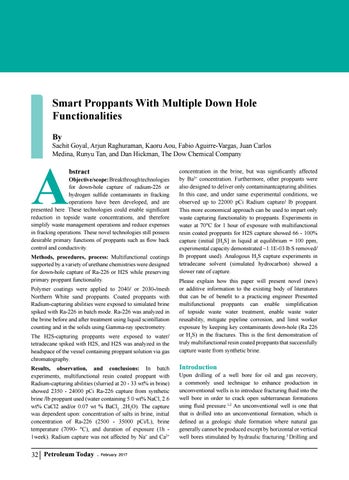Smart Proppants With Multiple Down Hole Functionalities By
Sachit Goyal, Arjun Raghuraman, Kaoru Aou, Fabio Aguirre-Vargas, Juan Carlos Medina, Runyu Tan, and Dan Hickman, The Dow Chemical Company
A
bstract
Objective/scope: Breakthrough technologies for down-hole capture of radium-226 or hydrogen sulfide contaminants in fracking operations have been developed, and are presented here. These technologies could enable significant reduction in topside waste concentrations, and therefore simplify waste management operations and reduce expenses in fracking operations. These novel technologies still possess desirable primary functions of proppants such as flow back control and conductivity. Methods, procedures, process: Multifunctional coatings supported by a variety of urethane chemistries were designed for down-hole capture of Ra-226 or H2S while preserving primary proppant functionality. Polymer coatings were applied to 2040/ or 2030-/mesh Northern White sand proppants. Coated proppants with Radium-capturing abilities were exposed to simulated brine spiked with Ra-226 in batch mode. Ra-226 was analyzed in the brine before and after treatment using liquid scintillation counting and in the solids using Gamma-ray spectrometry. The H2S-capturing proppants were exposed to water/ tetradecane spiked with H2S, and H2S was analyzed in the headspace of the vessel containing proppant solution via gas chromatography. Results, observation, and conclusions: In batch experiments, multifunctional resin coated proppant with Radium-capturing abilities (slurried at 20 - 33 wt% in brine) showed 2350 - 24000 pCi Ra-226 capture from synthetic brine /lb proppant used (water containing 5.0 wt% NaCl, 2.6 wt% CaCl2 and/or 0.07 wt % BaCl2 .2H2O). The capture was dependent upon: concentration of salts in brine, initial concentration of Ra-226 (2500 - 35000 pCi/L), brine temperature (7090- °C), and duration of exposure (1h 1week). Radium capture was not affected by Na+ and Ca2+
32 Petroleum Today
- February 2017
concentration in the brine, but was significantly affected by Ba2+ concentration. Furthermore, other proppants were also designed to deliver only contaminantcapturing abilities. In this case, and under same experimental conditions, we observed up to 22000 pCi Radium capture/ lb proppant. This more economical approach can be used to impart only waste capturing functionality to proppants. Experiments in water at 70°C for 1 hour of exposure with multifunctional resin coated proppants for H2S capture showed 66 - 100% capture (initial [H2S] in liquid at equilibrium = 100 ppm, experimental capacity demonstrated ~1.1E-03 lb S removed/ lb proppant used). Analogous H2S capture experiments in tetradecane solvent (simulated hydrocarbon) showed a slower rate of capture. Please explain how this paper will present novel (new) or additive information to the existing body of literatures that can be of benefit to a practicing engineer Presented multifunctional proppants can enable simplification of topside waste water treatment, enable waste water reusability, mitigate pipeline corrosion, and limit worker exposure by keeping key contaminants down-hole (Ra 226 or H2S) in the fractures. This is the first demonstration of truly multifunctional resin coated proppants that successfully capture waste from synthetic brine.
Introduction
Upon drilling of a well bore for oil and gas recovery, a commonly used technique to enhance production in unconventional wells is to introduce fracturing fluid into the well bore in order to crack open subterranean formations using fluid pressure.1,2 An unconventional well is one that that is drilled into an unconventional formation, which is defined as a geologic shale formation where natural gas generally cannot be produced except by horizontal or vertical well bores stimulated by hydraulic fracturing.3 Drilling and





